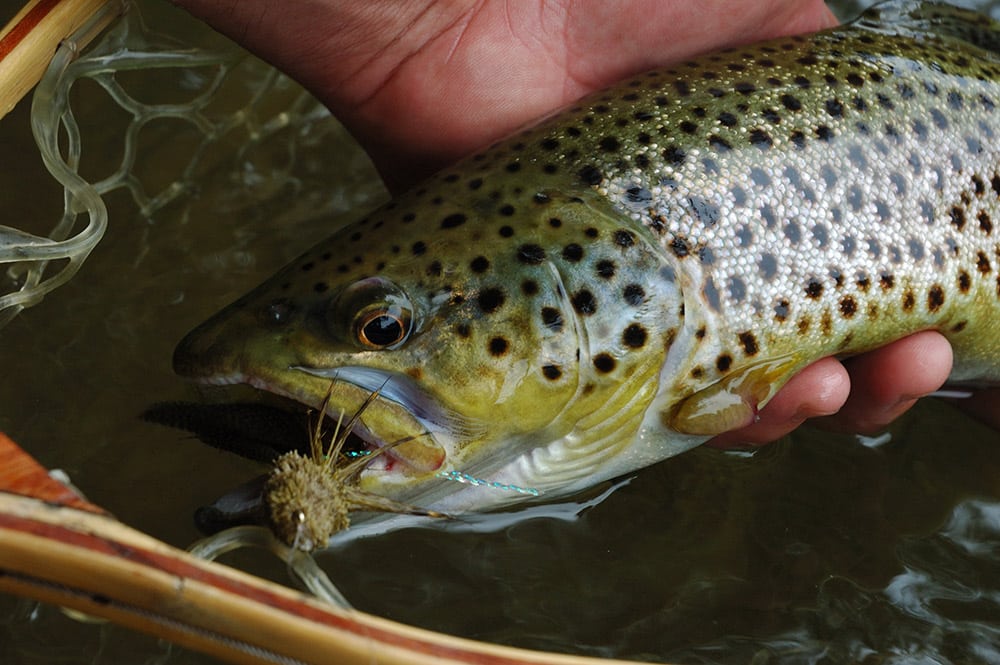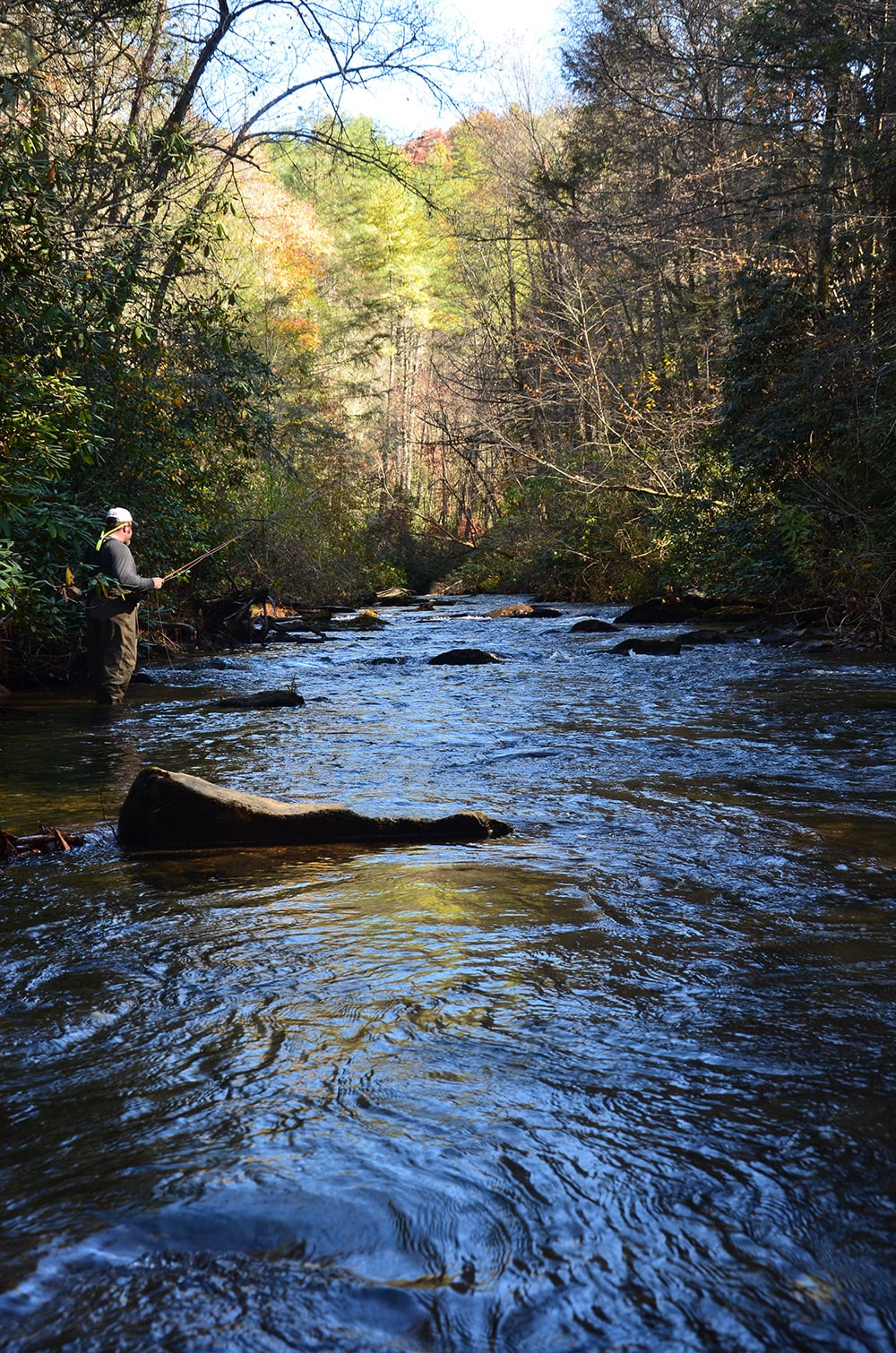An Angler’s Guide to Catching Aggressive Fall Brown Trout

It’s easy to get lost in the moment when you’re on a mountain stream surrounded by the beautiful reds, yellows, and oranges of autumn. But the stunning scenery of the season should also serve as a signal to trout anglers in Appalachia that it’s time to get aggressive. Brown trout are colored up and ornery leading into their fall spawn. There is no better time of year to sling streamers in search of the biggest, meanest brown in the river. Here, experts provide insight into spawning behavior, as well as where and how to find the best bites.
The Spawn
Brown trout are not native to North America. They were brought here from Europe during the mid and late 1800s and have thrived. In the East, they are the dominant predators in many of our cool mountain streams and large dam-controlled rivers. Once they reach a certain size, their diet becomes primarily piscivorous, which means they eat other fish. This makes them an awesome target for fly fishers who enjoy stripping streamers.
In the fall, brown trout begin their spawning behaviors. The females go on the move, looking for good habitat to cut out nests, called redds. Most of the time they push upstream, sometimes out of main rivers and up tributaries.
The males also mobilize. They go in search of the same type of habitat and receptive females. They become aggressive, particularly with other male brown trout, in competition for the chance to fertilize eggs. Male browns advertise their suitability as mates with brightening colors that mirror the warm tones of fall. More mature specimens develop an upturned tip of their lower jaw, called a kype, which they use in combat with each other.
Good conditions for a redd are a combination of water temperature, high oxygen content, a clean gravel bottom, and adequate flow to keep the nest clear of silt while the eggs incubate. Females seek this out where there is relatively shallow gravel, usually around riffles or accelerated flows toward the tail of a pool. Once a female finds what she is looking for, she constructs a redd by turning on her side and vigorously digging with her tail to cut an indentation in the gravel where she deposits her eggs. Males fertilize the eggs and then the female kicks gravel back on top of them.
The spawning process itself can take a few hours or a few days. A female will frequently cut and deposit eggs in several redds. The incubation period for the eggs could be a few weeks to a few months depending on water conditions, according to Jim Habera, a fisheries biologist with the Tennessee Wildlife Resources Agency. There is also a period when young egg-sack-dependent brown trout, called alevine, remain in the redd before entering the flow to feed on insects.
Anyone visiting a brown trout fishery in the fall should learn to identify redds to avoid disturbing them. This includes anglers, swimmers, and people throwing balls to dogs. A redd can be identified as an oval area on the streambed that is a lighter color than the surrounding gravel.
“If you’re a responsible angler, and you know somewhat what’s going on, you can easily spot the redds and avoid them while you’re wading,” said Habera. “It’s easy enough to learn how to recognize those and stay off them.”
Ethics of Fishing the Spawn
While most everyone agrees that trampling active redds is poor form, there are some conservation-minded anglers who argue against fishing during the spawning season all together.
The argument against harassing spawning browns seems logical. The spawn is a stressful time for fish. Even catching browns to release them makes it more difficult for them to reproduce and even to survive.
On top of this, brown trout become easier targets for anglers in fall. For a couple months leading up to and during the spawn, they are more visible as they move out of their summer lies. They group up to chase each other in the shallows, and the increased aggression of males makes them more susceptible to aggressive angling tactics. These behaviors can make fall fishing a lot of fun.
So, should we leave our heavy rods in their tubes during some of the best streamer fishing of the year?
“It can be a personal choice,” said Habera, when asked about the ethics of fishing the spawn. “If you’re catch-and-release fishing, I don’t see a problem with it at all.”
In a healthy brown trout fishery, Habera said fishing the spawn does not have an impact on the population level. Actively spawning females are not interested in eating, anyway, and in a healthy population there are plenty of males available to fertilize eggs.
He also noted a reduction in fishing pressure during the fall months, when the kill-and-grill crowd is more likely to be watching football or sitting in a deer stand.
“Fishing pressure goes way down by the time you reach October,” he said. “The folks that are still out there know what’s going on.”
Habera did make an exception for sensitive brown trout populations, which might be struggling to become established. He advised anglers to check regulations, because there are fisheries, or portions of them, where fishing is not allowed during the spawning season.
Timing the Action
Pinpointing the peak of spawning behavior in a particular stream or river can be tricky. Pre-spawn fish are the best targets for anglers because they are geared up, aggressive, and moving but not yet completely focused on doing the deed.
Habera said a wide range of habitat types, weather conditions, and other factors make spawning movements highly variable across the region. The process is triggered when the shortening length of days intersects with water temperatures that fall into the mid-to-high 40s.
He said wild brown trout in Tennessee mountain streams usually spawn in a window from mid-October through the end of November, while browns in big tailwaters like the South Holston or the Watauga spawn later, in mid-November and December. Even in the same stream or river, individual fish do not spawn all at the same time. There will likely be fish in all stages of the spawn for several weeks or more.
From the Mid-Atlantic down through the Southeast, a wide range from mid-September through December encompasses the brown trout spawning period. Action might heat up on a Pennsylvania spring creek far earlier than a north Georgia tailwater, or it might not. It depends on actual water conditions, not the date on a calendar.
Habera said anglers should pay attention to their local fishery reports. He mentioned a particular bridge on the South Holston River in northeast Tennessee where you can stand and actually watch hundreds of brown trout doing their thing on a shallow gravel bar. While this kind of obvious indication isn’t possible on most fisheries, anglers can expect brown trout to become more aggressive with the passage of each cold front of fall.
Coming out of a long hot summer, cooling waters drive increased feeding activity even before brown and brook trout color up for the spawn. Spring-spawning rainbow trout will be rejuvenated, as well. With fewer anglers on the water and fish feeding up ahead of winter’s scarcity of insect life, it’s just a good time to be a fly fisher.

Slinging Meat
Alex McCrickard isn’t too concerned with insect life when it comes to fall fly fishing. For him, fall is all about throwing large streamers and attempting to turn the largest brown trout in the river. He is a former fly fishing guide and the current aquatic education coordinator for the Virginia Department of Wildlife Resources. He’s fished all over the region and the world and has a particular passion for targeting pre-spawn brown trout with a bit of a go-big-or-go-home attitude.
“The month of October is prime-time here in Virginia,” he said. “These fish get particularly aggressive before the spawn. The males are putting their spawning suits on. They’re trying to attract the females, and they’ll get territorial as we get closer to the spawn, competing for the right habitat and then the right mate.”
Brown trout are notoriously cagey, especially the older, larger individuals. These big fish are tough to catch because they are wary and prefer large, infrequent meals in order to maximize calories while expending as little energy as possible. While smaller rainbows and browns eke out a living sipping tiny bugs from the flow, a big brown is not likely to even acknowledge a small insect, or your nymph or dry fly.
McCrickard said these larger fish need larger forage items to sustain their size and growth. They are opportunistic and will eat crayfish and large bugs, both aquatic and terrestrial, but mainly their diet consists of fish smaller than they are. That’s exactly what most streamer patterns were designed to mimic.
This feeding preference combined with the aggression of the pre-spawn increases the likelihood a big brown will swat your streamer. Lust and jealousy have a way of diluting inhibitions for males of many species. This includes brown trout. When a brown trout is swimming around itching for a fight, it is already cocked to lash out at whatever catches its eye.
Streamers are also effective for covering lots of water quickly in search of aggressive fish.
“Being stubborn and persistent, and putting time on the water is the only way you’ll be successful with a big fall brown,” McCrickard said. “You want to put the fly in front of a lot of different fish.”
Before and during the spawn, McCrickard targets likely big-fish habitat close to spawning areas. He prefers to give active spawners some space but has no qualms fishing to browns that are staged up off the spawning grounds.
“You’re targeting habitat where you would find a big fish, where they can exert as little energy as possible to get as much food as possible,” he said. “So… log jams, woody debris, drop-offs, shelves, big boulders that’ll cut the current down where you’ve got some depth, deep pools, riffles, those are all areas to prospect for larger fish.”
The style of fishing requires the angler to have an attitude that’s different from patiently picking apart a run with drag-free drifts of a nymph or dry fly. McCrickard said anglers must be willing to trade more consistent action in hopes of drawing just a handful of strikes in a day. The payoff is the potential to tie into a very large trout.
Large is relative. Big tailwaters have the size and nutrient load to grow giant brown trout two feet and longer, while a 14-inch fish might be a true trophy on some of the smaller high-elevation streams and rivers of the East. Gear selection should be tailored to fit the situation, and this always means going heavier when you’re fishing streamers.

The Biggest Brown in the Creek
McCrickard suggested carrying a heavy 5-weight or 6-weight rod on mountain streams and medium-sized freestones where you’d normally fish a 4-weight with a dry fly or a nymph. The heavier rod is good for battling heavier fish, and it also makes slinging streamers a lot more manageable.
With the limited depth of these streams, floating line is usually sufficient, but you’ll want a fly with some weight and a nine-foot leader that allows your streamer to get down in the water column. You’ll also want to fish heavier leaders and tippets than you would with dries or nymphs. Even on smaller streams, McCrickard doesn’t tie on streamers with anything less than 2x tippet. Most of the time he’s tapering down to 1x or 0x because the fish aren’t looking at the line, anyway.
“It can be a reaction strike. These fish are territorial, and they’re chasing down smaller forage fish,” he said. “They’re not inspecting a dry fly floating on a flat pool trying to decide whether to eat or not. These fish just make a decision and go for it.”
In terms of fly selection, it’s tough to nail down a pattern when you’re fishing for just a few bites over the course of a day. It’s a good idea to match the available forage in a stream and remember that you’re also trying to take advantage of a fish’s natural aggression. McCrickard said you could fish a size 6 to 8 Woolly Bugger but depending on the stream this might not be enough to draw the ire of the largest fish in the creek. Even a 12-inch brown will occasionally take a swipe at a two- or three-inch articulated streamer. If you’re swinging for the fences, you might as well go big.
This is especially true on smaller waters that are well known for producing large brown trout. McCrickard mentioned the South Fork Holston in southwest Virginia as a place where anglers gear up and fish very large streamers on a relatively small river. The Chattooga River on the Georgia/South Carolina border is another example of a smaller flow where persistently chucking large streamers can result in brown trout longer than 20 inches. Interestingly, Chattooga browns seem to prefer big streamers in colors that resemble young brown trout.
Tailwater Monsters
Everything ramps up a notch when you’re floating a big tailwater river. A 20-inch brown is an awesome fish on any river, but they grow much larger where conditions allow. If your goal is to catch a fish measured in pounds rather than inches, you should probably offer it some serious meat.
“If I’m fishing those bigger waters, I like throwing larger articulated flies,” McCrickard said. “I like the flies developed by Western fly tyers like Kelly Galloup and Charlie Craven, flies with deer hair heads, spun wool heads, multiple hooks and lots of flash. Big flies in that 5- to 6-inch range are going to push a lot of water and get the attention of the bigger fish.”
In terms of forage, big tailwater browns might feed primarily on shad or they might be eating perch or other trout. On rivers like the White River in Arkansas or the Chattahoochee north of Atlanta, anglers occasionally are stunned when 30-inch monsters rise from the depths to rip nine-inch stocked trout off their nymph rigs. Again, size is relative and browns are at their most aggressive this time of year.
McCrickard steps it up to a 9- or 10-foot 7-weight rod with a 250-grain full sinking line when he’s fishing tailwaters like Virginia’s Jackson River, Maryland’s North Branch of the Potomac or the South Holston in Tennessee. North Carolina’s Nantahala River tailrace and the Toccoa River in Georgia are a couple more fisheries worth mentioning when it comes to gearing up to target outsized brown trout.
With sinking line, or a sinking tip, there’s no need for a long leader. The weight of the fly line pulls the fly down, and fish that eat 6-inch streamers are not line shy. McCrickard goes with a 3-foot section of 0x tippet, which has a breaking strength of about 15 pounds. If the water has a little stain, he’ll fish a 3-foot leader of straight 20-pound-test mono.
“If I have that fish that’s two feet or larger, I’m feeling really confident having that fish on 20-lb. as opposed to having it on 2x,” he said.

More to Consider
Studies have shown that brown trout are partially nocturnal. They are more active in the low light of early mornings and late evenings. This low-light bite can go on all day when it’s cloudy and there’s a weather system approaching.
“It can be really good on cloudy, drizzly, rainy days,” McCrickard said. “Basically, low pressure systems can really turn the bite on, particularly if you have rain that’s starting to put a little dinge in the water clarity. Those conditions can align and really be to your benefit.”
Water clarity should also inform your fly selection. The rule of thumb in all fishing is to fish darker colors in dirty water and lighter colors in clear water. McCrickard prefers dark olive or black color combinations for the contrast they present in dingy water. More natural, lighter colors with some flash to reflect sunlight like fish scales are a good idea when the water is clear.
Finally, even though brown trout might be more prone to eat a streamer this time of year, the larger, older individuals are still extremely wary fish. If you want to catch one, you should commit to stripping streamers and stick with it.
“A productive day is relative. When you’re throwing a 10-foot 7-weight and a 250-grain full sinking line with 3 feet of 20-lb. monofilament, you’re not really going for numbers anymore,” said McCrickard. “You’re looking for one, maybe two fish. You kind of have to go out there with the mentality of, ‘I might get skunked today, but I might catch my best fish of the year… or the best fish I’ve caught in the last five years.’”
Nick Carter is author of “Flyfisher’s Guide to North Carolina & Georgia.” It is available on Amazon or by contacting the author at [email protected].







